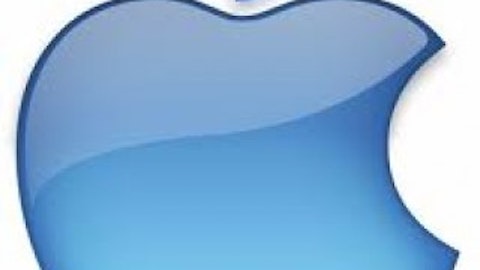Wall Street spent the opening weeks of this year bemoaning the underwhelming quarterly performance of Apple Inc. (NASDAQ:AAPL), but they have been quick in pivoting to happier tidings. The news that Google Inc (NASDAQ:GOOG) had exceeded market expectations drove the stock to a new 52-week high at $786.67, showing that this giant is still capable of growth. Both these market reactions are based on the same metric: growth (or lack thereof) in the core business.


What is the obvious lesson we can draw from Nokia’s failure? That disruptive innovation, not sustaining innovation is what defines a tech company’s long term outlook. I know it seems like a simple enough thing to remember, but it is very easy to get lulled into a false sense of security by current metrics of performance and forget the awesome power that disruptive innovation can have on an industry. That being said, let’s take another look at the long-term outlooks of Apple and Google Inc (NASDAQ:GOOG).
Apple
As I said above, Apple has used the power of innovation to great effect in building a brand and a company that is synonymous with elegance, functionality, and cutting-edge technology. The iPod, iPhone, and iPad were astronomically better than anything else when they were released so they obviously ruled their niches. Lately, however, their dominance has been challenged by Android-based phones, in particular Samsung’s Galaxy series. It has led to a new saga in the so-called “smartphone wars,” which really is just the free market in action. Competition is what made Google Inc (NASDAQ:GOOG) develop Android; Samsung, the Galaxy; and Nokia, the Windows phones/Surface. It is also what forced RIM to reinvent themselves as Blackberry and introduce the BB10. The end result of this rebalancing is a market now saturated with devices that are near identical in quality, so anyone looking to “win” the smartphone wars must introduce a transformative product, and Apple’s recent record is uninspiring. The iPad-mini? Apple Maps? Neither of them bolster my confidence in Apple’s ability to create a game-changing product without the visionary leadership of the late-great Steve Jobs. Just look at their cash account over the last few years:

Clearly, Apple is on the wrong side of a fine line that separates fiscal responsibility from hoarding idle cash. They’ve kept an intense focus on their principal function by not allowing free-range experimentation from their engineers or adventurous acquisitions into other industries, and they will soon pay the price for it.
Google Inc (NASDAQ:GOOG) has one of the most unique management systems in the world. They are renowned for being able to promote an ethos of ‘innovation for the sake of the innovation’ and then use it to thrive as a business enterprise. After all, they were a web services company that expanded into the mobile devices market successfully with the Android OS. It was a paradigm shift in their business model that came from a willingness to entertain bold ideas, and they do not plan to stop there. One of the most underappreciated factors of Google Inc (NASDAQ:GOOG)’s long term outlook is the driverless car.
Google has developed a technology that allows a vehicle to operate autonomously using a system of external sensors to detect its surroundings. They have already conducted hundreds of thousands of hours in road testing the vehicle using a Toyota Prius without ever having a crash related to the software. Since most vehicular accidents are caused by human error, widespread adoption of these cars could reduce the frequency of accidents by 90%.
Most investors feel that the barriers facing the commercialization of driverless cars make it a pipe dream. They say it is too expensive, legally ambiguous, and unappealing to consumers. Not to mention that everyone from oil producers to car makers have a vested interest in halting the march of progress by mobilizing an army of lobbyists if the technology looks close to market ready.
I understand the criticisms, but they are easily dispatched. 1) Anything that is in the prototype phase will see its costs per unit reduced when it is produced en masse, and the exponential nature of technological growth has an inverse relationship with price. 2) California, Nevada, and Florida have already legalized autonomous cars, which establishes a market of 60 million consumers. Even the US Department of Transportation is doing research on the type of infrastructure that would be required, saying that “It is anticipated in the future that most of the vehicles will be fully automated; thus the movements of those vehicles will need to be optimized in the network.” 3) Consumer attitudes may at first be skeptical, but mounting evidence of the reliability and increased safety of using driverless cars will induce a change of heart in people. The same proof will make it difficult for lawmakers to obstruct legalization of autonomous cars across the country.
Even with my optimism it is obvious that full scale product integration will take some time, so Google won’t see the fruits of their labor for a while–but the same cannot be said about their share price. Once the prospect of mass production is imminent there will be a gigantic surge in Google’s stock as investors price in future revenue projections that include this cash cow. This is a $2 trillion industry in which Google is poised to dominate, so a lowly P/E of 24.38 means that Google’s multiple has room to climb.
Conclusion
Any portfolio that has a long investment horizon and can afford to ride out some short-term volatility should definitely include Google instead of Apple. Apple is mired in an industry where it no longer has a competitive advantage and no inclination to branch out into other industries, so where will any big gains come from? If you are buying Apple now, then you better reconcile yourself to the fact that it will be an income stock with moderate growth.
At the core of every investor is this nagging feeling that they wished they knew then what they know now. Investing in just one disruptive technology is the kind of windfall that haunts every person’s dreams. If only they had bought Apple, or Intel, or Amazon when those companies had yet to make their breakthroughs, wouldn’t that be perfect? The truth is that those opportunities are not clear in real time because you have to be contrarian or just more patient than everyone else. In this case, you can benefit from the fact that most people see driverless cars as part of a distant future that includes resorts in space and vacations to Mars.
The article Google’s Untapped Gold Mine, and Apple’s Biggest Obstacle originally appeared on Fool.com and is written by Gaurav Seetharam.
Copyright © 1995 – 2013 The Motley Fool, LLC. All rights reserved. The Motley Fool has a disclosure policy.





